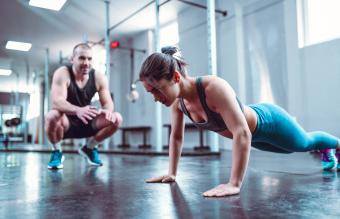
People often view massages as something to just be enjoyed on a trip to the spa or on special occasions such as birthdays. However, there are other reasons to get massages, particularly if you exercise frequently.
Massage Benefits Exercise
According to The American Massage Therapy Association sports massage can help improve conditioning and increase the rate of recovery for athletes of all skill and activity levels. The association also maintains that sports massage can "reduce muscle tension . . . increase range of motion . . . decrease muscle stiffness and fatigue . . . improve exercise performance . . . enhance athletic performance [and] help prevent injuries," to name just a few of massage's benefits.
According to an abstract published in Science Translational Medicine in 2012, bicyclists' muscle tissues were biopsied at different points before and after exercise and massage to determine massage's exact effects. Intense exercise causes tiny tears in your muscles, which leads to inflammation during your muscles' recovery. The study showed that massage not only reduces inflammation, it also increases the energy in your cells, which allows them to repair and recover faster. Both of these factors are key to increasing your athletic performance because if you feel better and recover faster, you'll be able to worker harder during your next session.
Types of Massages
While there are many forms of massage, here are the most common, especially for athletes.
- Swedish massage: This type of massage is gentler than other types of massage, and this method uses light or medium-pressured strokes and kneading to relax you and reduce stress.
- Deep tissue massage: This type of massage uses slow, powerful strokes to reach the deepest layers of your muscles, loosen knots, and treat injuries.
- Sports massage: This kind of massage is typically gentler than a deep tissue massage, and it's used to treat and prevent sports injuries. It typically focuses on a specific trouble spot, such as an injured shoulder, and may involve some assisted stretching.
- Trigger point massage: This massage works the tightest muscle fibers that form after injury or overuse. A trigger point typically causes pain that radiates to other body parts, and a trigger point massage uses cycles of pressure and release to loosen the trigger point.
When to Get a Massage
Massage clients are generally advised to refrain from any strenuous activities within 24 hours after getting a massage. Since massages soften your muscle tissue, exercising vigorously within 24 hours can cause your muscles to return to their initial positions or move into new painful and tight positions. For this reason, especially if you work out frequently, you may want to get a massage soon after exercise or on the night before a rest day so that your massage recovery time doesn't impact your workout routine as much.
Additionally, massage's benefits are temporary. To use massage to increase your athletic performance, you should get massages more than just once a month. If you're a high-performing athlete, you should get a massage once a week, but if that isn't feasible, aim for at least twice a month. If you're getting a massage to prepare for an athletic event, such as a race or a competition, it's best to get the massage three to five days beforehand to allow enough time for any residual soreness to wear off before you compete.
How to Find a Good Massage Therapist
Choose a Massage Professional
Make sure you look for a licensed massage therapist. You want the person doing your massage to be knowledgeable about muscles and anatomy so you get the results you want. When you call to book an appointment, make sure you ask which type of massage the therapist specializes in to make sure his or her specialty suits your needs.
Ask for Recommendations
You may also want to consider asking for therapist recommendations from your physical therapist or chiropractor if you see one. Another way to get a good therapist is to ask for recommendations from others who participate in your sport and seek the same benefits that you do. For example, it might not do you any good to get a recommendation from a friend who loves Swedish massages if you want deep tissue to break up the knots in your shoulders.
Trust What Your Body Tells You
What it all comes down to is knowing your body and trusting what it tells you. If you try a new massage therapist and something doesn't feel right, speak up. A good massage therapist should be able to adjust his or her technique and level of pressure to suit your needs. If not, feel free to end the session early. It's much better to walk out of a bad massage early than to find yourself tighter and in more pain because of poor technique. Your massages should help enhance your exercising abilities, not hamper them.
Consult Your Physician First
Even though massage can have positive effects on your ability to exercise and participate in sports, it's still important to speak with your physician first if you experience significant pain and/or injury after working out. Deep massage, if not done by a trained therapist, can cause bruising and internal bleeding, which will increase your pain. You should also avoid deep massage if you're on blood-thinning medications. Your physician will assess your overall health, and then determine if you need treatment that a massage therapist can't provide. Even if you don't, he or she may also be able to recommend a good licensed massage therapist for you.







